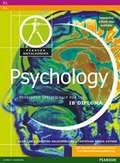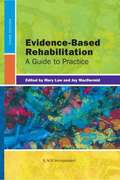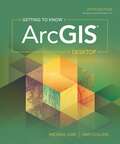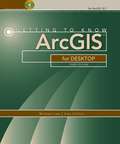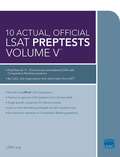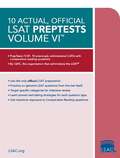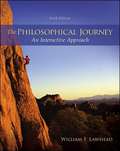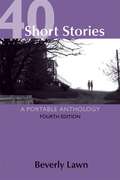- Table View
- List View
Pearson Baccalaureate Psychology
by Alan Law Christos Halkiopoulos Christian Bryan-ZaykovA textbook for students and teachers of the International Baccalaureate Diploma, written and developed by practicing IB teachers.
Evidence-based Rehabilitation: A Guide To Practice (Third Edition)
by Mary Law Joy MacDermidWhile evidence-based practice (EBP) has greatly influenced rehabilitation in the past decade, it continues to evolve and practitioners need guidance to implement evidence into their practice. Evidence-Based Rehabilitation: A Guide to Practice, the best-selling text providing step-by-step EBP guidance for rehabilitation professionals, has been updated into an expanded Third Edition. <p><p> In Evidence-Based Rehabilitation, Third Edition Drs. Mary Law and Joy MacDermid, along with their contributors, explain evidence-based rehabilitation, the concepts underlying EBP, and build the reader's knowledge and skills through specific learning. The text is organized by the steps of the EBP process--introduction to EBP, finding the evidence, assessing the evidence, and using the evidence. <p> EBP focuses first and foremost on making the best decisions for each client and using the best information available. For many rehabilitation practitioners, building skills in EBP is best done one step at a time. Evidence-Based Rehabilitation helps the rehabilitation student and practitioner develop his or her knowledge and skills to implement evidence-based rehabilitation in practice.
Getting to Know ArcGIS Desktop (Getting to Know ArcGIS)
by Michael Law Amy CollinsBecoming the go-to person for ArcGIS Desktop? Start here. <p><p> This book is a comprehensive introduction to the features and tools of ArcGIS Desktop. Through hands-on exercises, readers will discover, use, make, and share maps with meaningful content. They will also learn how to build geodatabases, query data, analyze geospatial data, and more. The latest edition has been updated to the most current version of ArcGIS Desktop 10.6. <p><p> This book is suited for classroom use, independent study, and as a reference.
Getting to Know ArcGIS for Desktop (Getting to Know ArcGIS Series)
by Michael Law Amy CollinsGetting to Know ArcGIS for Desktop is a workbook for beginners. Its detailed, step-by-step exercises teach you the core functionality of ArcGIS for Desktop software: how to make maps, carry out spatial analysis, and build and edit spatial databases in the context of realistic projects. The exercises are supported by conceptual discussions at the start of each chapter and as needed throughout the book. Getting to Know ArcGIS for Desktop is a hands-on workbook that’s meant to be a practical manual for classroom lab work or on-the-job training. If you have no GIS background, chapter 1 will give you a quick overview. If you have no ArcGIS software experience, chapter 2 will provide a background on Esri GIS software products. The remaining 18 chapters require you to work through software exercises as you read. Each of these chapters contains two to four exercises that focus on a particular GIS task or problem. Many common tasks are covered, including navigating digital maps, finding GIS data online, setting map projections, symbolizing and labeling maps, classifying data, making map layouts, querying maps, analyzing spatial relationships, building spatial databases, editing data, and geocoding addresses. Each new exercise in Getting to Know ArcGIS for Desktop is a fresh starting point, with the maps and data you need already prepared for you. This volume is heavily revised for the third edition. New authors Michael Law and Amy Collins replaced a majority of the datasets for a fresh learning experience. All the exercises were designed for compatibility with ArcGIS 10.1 for Desktop. Although still intended for beginners, the content is no longer limited to the most basic functionality. Some advanced capabilities that are available with Standard and Advanced licenses are discussed. As the chapters progress, instructions and graphics become noticeably more streamlined, assuming increased knowledge and recall by readers as they move forward. Several new features have been added to the book to enhance the learning experience: learning objectives, chapter summaries, questions for critical thinking, software tips, independent-challenge tasks (“On your own"), a glossary of key terms, and navigation tabs.
10 Actual, Official LSAT Prep Tests, Volume V: Prep Tests 62-71
by Law School Admission CouncilEach book includes: 10 previously administered LSATs, an answer key for each test, a writing sample for each test,score-conversion tables, and sample Comparative Reading questions and explanations.
10 Actual, Official LSAT Preptests (Volume #6)
by Law School Admission CouncilFor pure practice at an unbelievable price, you can't beat the 10 Actual series. Each book includes: 10 previously administered LSATs, an answer key for each test, a writing sample for each test,score-conversion tables, and sample Comparative Reading questions and explanations.
The Philosophical Journey: An Interactive Approach (Sixth Edition)
by William LawheadThe Philosophical Journey: An Interactive Approach is a text with readings that enhances comprehension of philosophical study by encouraging students to ponder, explore, and actively participate in the learning process. Philosophy becomes a personal journey for students through Lawhead's unique pedagogy that introduces philosophical concepts through practical application in the form of primary sources, interwoven exercises, and sections that encourage critical thinking and further exploration of core concepts.
40 Short Stories: A Portable Anthology (4th Edition)
by Beverly Lawn40 Short Stories, part of the highly successful Bedford/St. Martin's portable series of anthologies and guides, continues to offer a balanced mix of classic and contemporary short fiction for a low price. Editorial features -- such as instruction on how to write about fiction and a glossary of literary terms -- are located in the back of the book so the focus can remain on the stories. The stories themselves are arranged chronologically to help students trace the evolution of the short story genre. This book's small size, low price, and versatility make it the perfect anthology for a variety of classes, including introduction to fiction, composition, creative writing, or introduction to literature.
40 Short Stories: A Portable Anthology
by Beverly Lawn Joanne DiazGathering forty important short stories in a portable and economical format, the second edition includes even more of the fiction instructors want to teach and more of the help student readers need.
Chemical Interactions Resources: Images, Data, and Readings
by Lawrence Hall of ScienceThis book explores chemicals, for instance, their formation, reactions and properties.
Foss Weather and Water Lab Notebook
by Lawrence Hall of ScienceA lab notebook to accompany the student text.
New Plants
by Lawrence Hall of ScienceIntegrate reading and language arts in the context of science with original student books developed specifically to complement FOSS modules. Students extend and reinforce their classroom discoveries and vocabulary after their hands-on explorations of life, earth, and physical science concepts. Large, colorful photographs and appropriate text enhance the science learning experience.
Solids and Liquids
by Lawrence Hall of ScienceIntegrate reading and language arts in the context of science with original student books developed specifically to complement FOSS modules. Students extend and reinforce their classroom discoveries and vocabulary after their hands-on explorations of life, earth, and physical science concepts. Large, colorful photographs and appropriate text enhance the science learning experience.
Science Resources (Grade #4)
by Lawrence Hall of Science Team at the University of CaliforniaHandbook for fourth graders to understand and appreciate the fundamentals of science grouped into 3 modules - Magnetism and Electricity, Environment and Solid Earth.
Plantas y animales
by Lawrence Hall of Science Universidad de California en BerkeleyNIMAC-sourced textbook
Recursos de Ciencias
by Lawrence Hall of Science Universidad de California en BerkeleyNIMAC-sourced textbook
Air and Weather
by Lawrence Hall of Science University of California at BerkeleyNIMAC-sourced textbook

